It’s so easy to make purchases online without ever connecting with a sales rep — the internet usually does the selling for you. This is why getting customer reviews is so important. They can have a huge impact on if a customer purchases from you or not.


The fact of the matter is, your company's best marketers and sales reps aren't your employees — they're your existing customers.
We’ll cover:
Why Customer Reviews are Important
Customer trust in businesses is fading. HubSpot Research found that customers trust recommendations from friends and family over any type of online marketing and advertising your brand can create. And in the absence of trusted recommendations, according to BrightLocal, 98% of consumers read online reviews for local businesses trust online reviews as much as personal recommendations — the single most trustworthy and credible source of "advertising" out there.
HubSpot Research also found that 60% of consumers believed customer reviews were either trustworthy or very trustworthy — meaning that businesses that can accumulate positive reviews had a good chance of them helping a customer make a purchase decision.
The same BrightLocal survey found that positive customer reviews make 73% of customers trust a business more, and 57% of customers visit a company's website after reading positive reviews. That also means that, in order for businesses to grow in today's competitive, online-first marketplace, they need happy customers sharing positive reviews of their experiences in order to even get visitors coming to their site for the first time.
The good news is, your customers are usually more than happy to help you out with this: The same survey found that, of the 74% of customers who were asked to provide feedback, 68% were willing to do it. So don't be intimidated by the prospect of asking your customers for a favor — because all you have to do is ask, and they'll likely be happy to help you out.
Good/Positive Customer Review Examples
1. HubSpot
A great customer review will be one that is detailed and specific. In this example, a HubSpot employee left a review on Glassdoor. They noted how long they'd been working at HubSpot, what they liked about it, and what they're most proud of in terms of company growth.
Additionally, a great way to continuously encourage positive customer reviews is to respond to your reviews. In the screenshot below, you'll see HubSpot's Chief People Officer responded to the review with gratitude and agreement.
2. Amazing Lash Studio
Positive customer reviews often call out amazing customer service. This is a great example because the customer discussed who they had been seeing at the Lash Studio, and why her customer service was so excellent.
Additionally, the customer proclaims that she is a customer for life, and her review indicates that she has gone from a customer to an advocate because of the great customer experience.
If you get a detailed review that calls out your customer service, then you're doing something right.
3. Ashley Leavitt Photography
This is one of my favorite positive customer reviews because the customer felt so compelled by her experience that she updated a previous review.
The photographer provided an excellent customer experience in 2020, so the customer left a review. Then, she used her services again a year later and left an even more detailed review citing why the experience was so positive.
Additionally, the best customer reviews will have photos. This user included several photos she got from her photoshoot, which helps potential customers decide whether they want to hire this photographer.
So, how do you get your customers to write glowing reviews that help close deals? How do you ensure a customer is satisfied and happy enough to ask for the kind of positive reviews you need? Read on to adopt strategies that will make generating positive customer reviews a cinch.
How to Ask for a Review
- Identify the right moments to ask according to their buyer's journey.
- Choose a method that works for you at scale.
- Personalize your request.
- Offer an incentive.
- Communicate their importance to customers.
- Ask the customer in person.
- Leverage moments of customer happiness.
- Begin with an open-ended question.
- Reduce the friction where you can./Make it easy
- Provide a template.
- Let them know how long it will take.
- Follow up on your request.
1. Identify the right moments to ask according to their buyer's journey.
Make sure you're soliciting customer reviews at the right moment in their journey with your business to get optimal results.
Business relationships have natural ebbs and flows, from times of sticker shock or buyer's remorse before a successful result to times of euphoria after their pain/problem is successfully resolved.
Think about it: If you ask for a review at the wrong moment, it could result in a customer leaving a negative review that hundreds of more people read when considering whether or not they want to buy from your business.
Ask for customer reviews at strategic moments along the customer journey, like:
- After they experience or demonstrate success with your product or service
- When they re-purchase or re-order
- After they tag your brand in a post on social media
- If they are spending time on your website browsing other products or services
- If they refer another customer to you
These are just a few examples of signs that your customer is satisfied enough that they would leave a positive review of your business.
For example, Etsy asked me to review a recent purchase approximately one month after I received it. I ordered a party favor for a friend's bridal shower, so one month later was the right time frame to make sure I had time to enjoy and use my product.
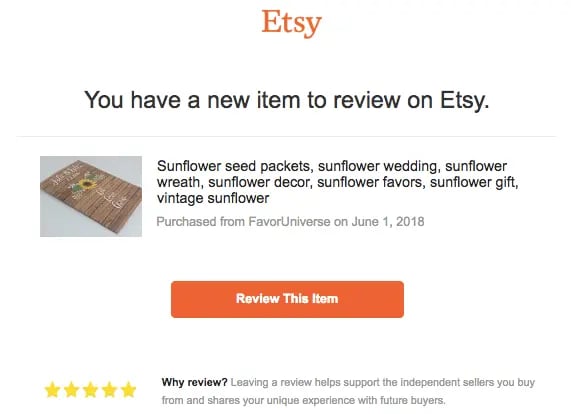
On the other hand, some products and services will work within different time frames. For the ride-sharing app Lyft, I usually receive a prompt to review my experience with my ride and driver immediately after the ride ends. For the language-learning app Duolingo, I receive a prompt to review the app in the App Store after completing a lesson or achieving a milestone in the language I'm learning.
2. Choose a method that works for you at scale.
According to BigCommerce, 50 or more reviews per product can mean a 4.6% increase in conversion rates. The big takeaway here is that more reviews mean more proof and, therefore, more trust in your brand. In addition, dated reviews inspire less confidence than recent ones.
To truly fuel your flywheel and benefit from testimonials as social proof, getting them should become a regular part of your process. Here are some common avenues to help you ask for reviews at scale:
- Train your team to ask for reviews after every successful project or service
- Incorporate requests for reviews as part of your email marketing automation campaigns
- Use NPS to identify promoters (your happiest customers) at scale and have your service team foster relationships with them
- Include review links after checkout or on thank-you pages as an optional final step
Whatever you choose, it should be consistent and often.
3. Personalize the request.
Personalization not only helps with building customer relationships, but it can also improve your prospects of getting a review. You can do this by creating a specific review type for the product or service the customer purchased, or to the device they used.
For example, if they made the purchase via mobile device, they should be able to review the product on their mobile device as well.
4. Offer an incentive.
If you’d like your customers to go the extra mile for you to provide a review, offering them something in return is an excellent motivator. This could be a small discount, free gift, or exclusive offers of future products or services.
By offering an incentive to your loyal customers, you can not only get the word out about your brand, but can build stronger relationships. This could lead to not only more reviews, but referrals too.
5. Communicate the importance of referrals.
Happy customers want to see your business succeed — especially if they have been loyal and continue to use your products or services. You can encourage customers to write reviews by communicating how important reviews are to your business.
State how many of your customers found out about your business through reviews. That way customers can see they have a direct impact on your business and its success.
6. Ask the customer in person.
If you work in a customer success manager or account executive role and you have close relationships with the portfolio of customers you work with, don't hesitate to add a personal touch and ask your customers to review their experiences in person.
If you're taking your customers out to coffee or lunch, or if you invite them to one of your company events, keep things conversational, and ask them how they're doing with your product or service. (Ideally, you'll know if they're achieving success or not based on your regular communications, so you'll ask customers that you know are achieving goals already.)
If your customers tell you they're seeing success, let them know that you value their opinion and their loyalty and that you'd appreciate them helping you get the word out to potential new customers. Remember the data from the beginning of this post? Most customers will leave you a review — all you have to do is ask.
7. Leverage moments of customer happiness.
If you've just made a major breakthrough for a client, or if you've received praise or positive feedback from them, you've just come up to a point of customer happiness. At these moments, they may not only be more inclined to give you a review as a way of providing reciprocity for good work, but they are also more likely to give you a good review.
8. Begin with an open-ended question.
Don't start by coming out and asking directly for a customer review.
Instead, start a conversation — and use an open-ended question to kick off the process.
By asking customers "How are you liking the product?" or "Are you ready to renew/purchase again?" or "How was your recent interaction with customer support?" you can start a conversation and gauge their level of satisfaction before actually asking for the review.
This is helpful in two ways:
- You can source helpful customer feedback
- You can avoid the awkward mistake of asking a customer for a review before learning they had a bad experience
Use the open-ended question to genuinely collect customer feedback — and to sneakily make sure the customer is happy before offering them a reason to submit a review. There's nothing you can do about negative reviews coming onto various sites, but if there's a customer who needs a resolution, focus on that before you ask them to rate your business.
An open-ended question in an email subject line — as BioClarity did here — prompted me to get ready to give an answer as a reply or in the form of a review:

9. Reduce the friction where you can.
If leaving a review becomes a hassle, your customer will be less likely to do it. That means you should make it as easy as possible, especially when asking for a testimonial over email. Here are some ideas:
- Include multiple options so that the customer can choose the platform they're most comfortable on
- Include a link directly to the page where they leave a review to minimize the number of clicks or steps they must take
- Give them a prompt so they're never at a loss on what to write (e.g. "Will you leave a review about your experience with your most recent store visit?")
10. Provide a template.
As we mentioned, making it easy for customers to leave a review is key. Keeping with that theme, using a template will save users time filling out a review.
You can use a variety of formats, some with little writing at all like a Net Promoter Score which ranks customer satisfaction with a sliding scale of 1 to 10. Customers merely have to check a box for a series of questions. Additionally you can go with a simple star-rating for customers to make their choice or use a short form.
If using a form, it could be helpful to leverage AI to help customers complete their entries faster with autofill responses. Using tech like sentiment analysis can help with language processing.
11. Let them know how long it will take.
One of the biggest points of friction that should be called out is time. If the customer perceives that they don't have time to fit in a review, they won't. However, if you address this objection beforehand during your ask, you can change their thinking while you have the momentum. For example, you might say or write "It will only take 2 minutes" as a side-note or post-script to the request.
12. Follow up on your request.
Get comfortable with knowing that you may have to ask for a review more than once. Everyone gets busy and your customers may need a reminder to give a review if you’ve already asked them previously.
This is not an excuse to badger them with requests. Instead, if you have customers that typically write reviews, but they haven’t for a certain product this round, reach out with a gentle reminder. Chances are, they simply forgot or didn’t have time when you sent the original request.
Now that you have these review-getting strategies in your toolkit, let's explore how to make sure they're positive.
How to Get Good Reviews
- Create different spaces to leave reviews.
- Optimize your content.
- Create incentives.
- Meet customers where they are.
- Respond to every review — even negative ones.
- Share positive customer reviews you've already received.
- Give your customers a positive review first.
- Host an event.
1. Create different spaces to leave reviews.
Before potential customers even make it to your website to learn about your business, make sure they can learn about you no matter where they're conducting online research about making a purchase.
There are a few typical third-party review sites people consult to learn more about a business or a product:
Yelp
BrightLocal found that Yelp and Facebook were consumers' most trusted sources of customer reviews in the U.S., so make sure your business is registered and up-to-date. You can learn how to claim your business (or add it, if your business is brand-new) using Yelp for Business Owners.
Make sure you're regularly monitoring communications coming from this profile — responsive business owners are highlighted with an average response time and response rate that could encourage readers to move forward in the process towards becoming a new customer.
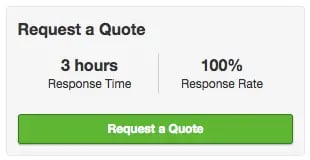
You should also claim your business' Facebook Page so potential customers can find you to learn more about you without having to leave their social network. This is another site that rewards high levels of responsiveness, so make sure you assign someone to monitor incoming messages across the channels you're trying to optimize for new customer acquisition.
![]()
Next, use Google My Business to claim your business on the world's biggest search engine, where potential customers might find you if they're searching for information on Google, or searching for directions in Google Maps. (This is of particular importance to brick-and-mortar businesses trying to attract foot traffic -- learn more about local SEO in this blog post.) People also leave reviews using Google, which appears in the search results for your business, as shown below if you Google "HubSpot."
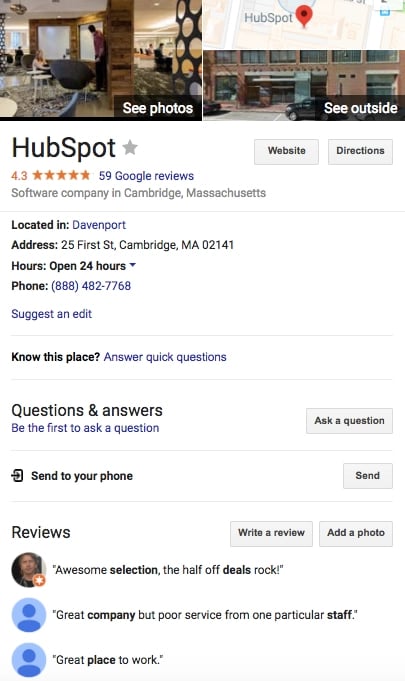
Amazon
If you're an Amazon seller, make sure to claim and customize your Amazon page.
Amazon serves up a lot of different results for different searches, so make sure your Amazon page tells your business' story the same way your website does. If a shopper finds your brand over the course of an Amazon search, make sure your Page highlights product details, testimonials, and reviews.
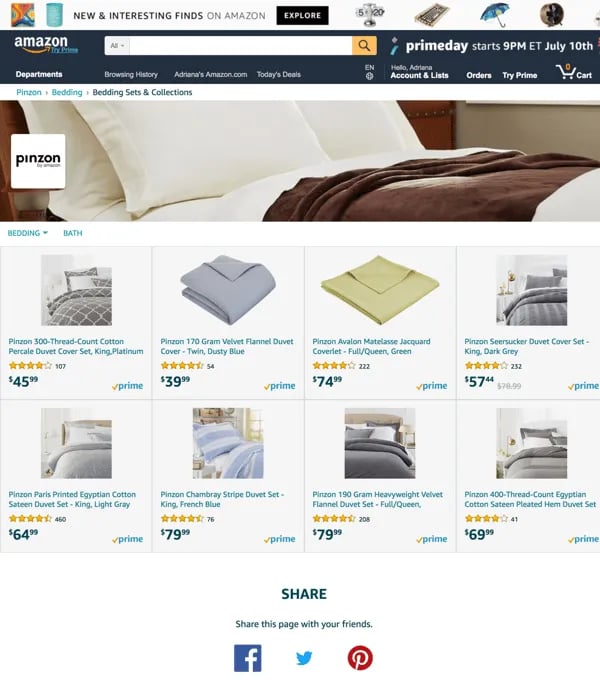
Better Business Bureau
For businesses in the U.S., Mexico, and Canada, you can register with the Better Business Bureau — another highly trusted source of customer reviews. By claiming your business on the BBB, you can access more candid customer reviews and become accredited on the site — which lends greater credibility and trustworthiness to you if customers are deciding between options using these reviews and ratings.
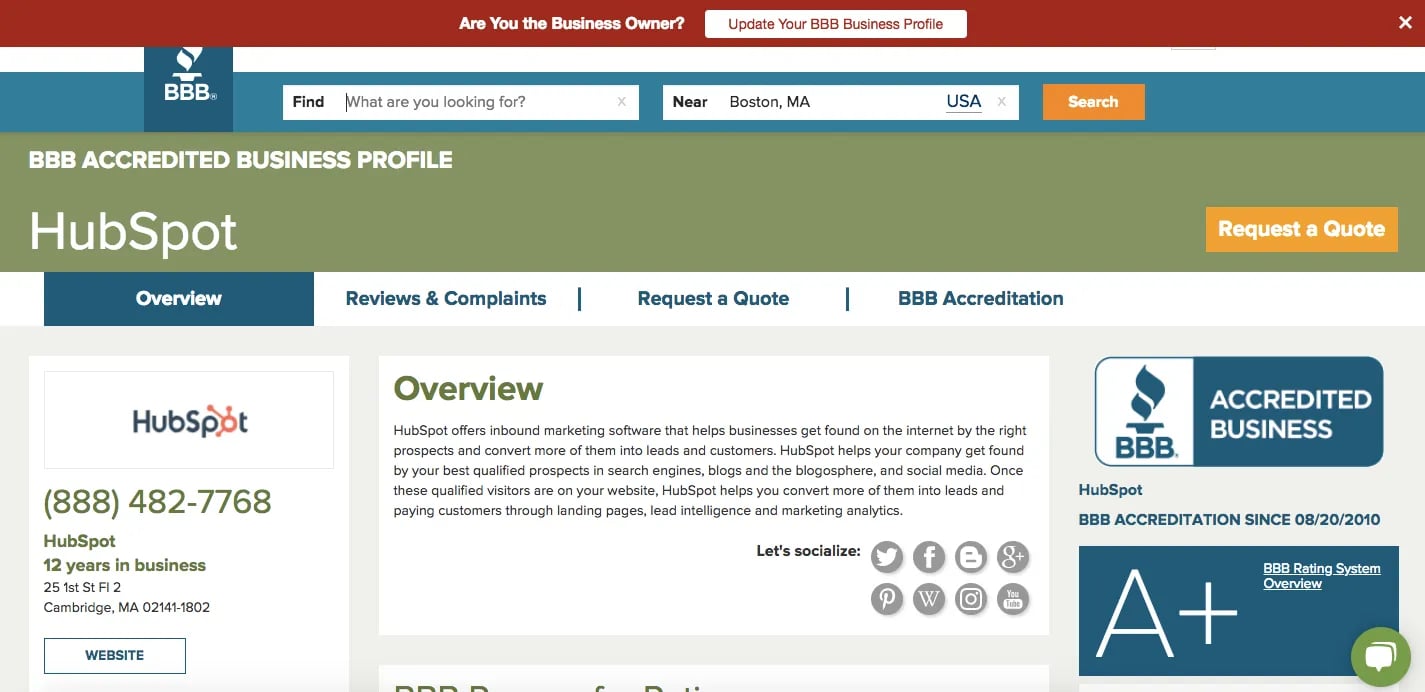
There are also industry-specific review sites you should claim if they're popular within your business's vertical — such as TripAdvisor and Oyster in the travel and hospitality industries, G2Crowd, and Finances Online in the software industries, and OpenTable and HappyCow in the restaurant industries. Make sure your contact information, website, hours, and key offerings are available on these more niche sites, too.
2. Optimize your content.
Your customer reviews might be coming in unsolicited from happy — or unhappy — customers on third-party sites.
But once people are already on your site, make sure it's easy for them to leave reviews there, too.
Optimize your website, blog posts, social profiles, and emails to provide quick and easy avenues through which to write reviews by:
- Setting up website badges to quickly and easily direct visitors to your Yelp, Facebook, and Amazon pages to read and leave reviews
- Optimize your website for mobile devices for people who come to your website when they're browsing social or conducting searches on their phone
- If you're asking for customer reviews via email, keep the asks short and sweet.
Here's a review request I received from a tour company in Charleston. It wisely included a link to various ways to review the company on the actual receipt of my purchase shortly after taking the tour. (For those curious, I highly recommend the haunted graveyard tour if you're ever in Charleston, SC.)
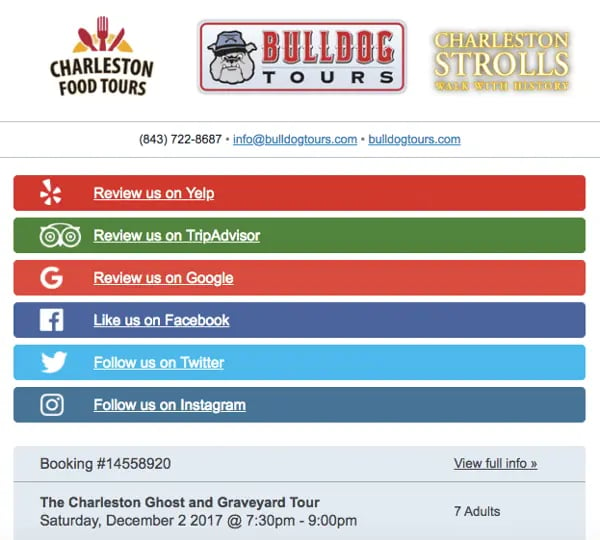
3. Create incentives.
Your time is valuable, and so is your customers', so make sure you're giving customers a reason to leave a review.
Offer incentives to make your customers want to write a review — such as discount or coupon codes, entrance into a contest for an even bigger prize, or gift cards for coffee, online shopping, or cold hard cash.
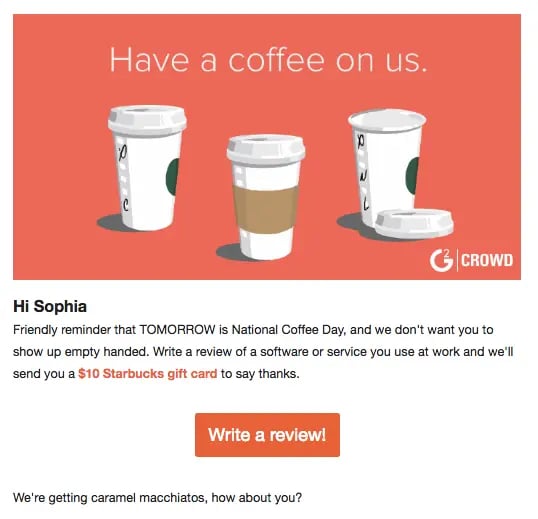
A review request (with a caffeinated incentive) from G2 Crowd
4. Meet customers where they are.
Don't email your customers to ask them to leave you a positive review on Yelp.
Instead, make sure your requests match up with the avenue where you want your customer to write a review. If you're sending out an email asking for a customer review, make sure the email links to exactly where they can leave their feedback. If you want reviews on your Facebook Page, send the request via Messenger. And if you have to ask for a customer review cross-platform, make the request as integrated as possible — for example, by linking to your Yelp page in your email signature, or asking customers to review their purchase from your Amazon store in a follow-up email post-purchase.
Here's a review request I received from a third-party Amazon seller — along with some helpful tips for how best to use the product I had recently purchased:
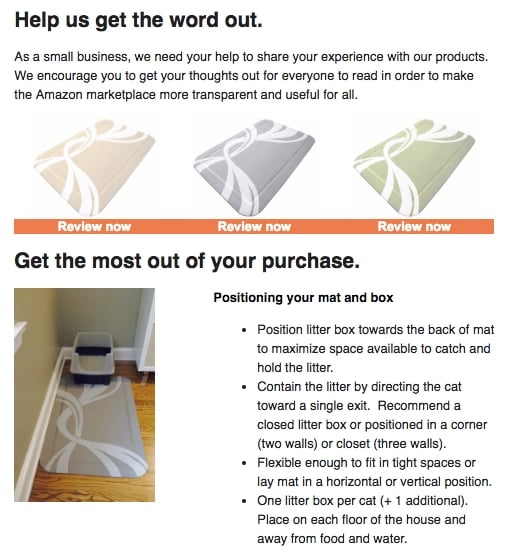
5. Respond to every review — even negative ones.
Nobody's perfect, and mistakes sometimes happen that result in a customer leaving a scathing one-star review on your website, on Facebook, or on Yelp.
When you get a one-star review, though, make sure to take the time to respond thoughtfully, without being defensive, to come to a resolution. It's the right thing to do if you work in customer service, and it could actually help your business in the long run.
Harvard Business Review found that businesses responding to negative reviews online actually resulted in better ratings overall. Your customers are human beings too, and the value of empathetic and compassionate customer service strikes a chord and actually leads to an uptick in total reviews, particularly positive ones.
Here's an example of how HubSpot responds to reviews on our Glassdoor page. Although not technically "customers," showing prospective employees that HubSpot responds to feedback and takes it seriously helps our employment brand, too.
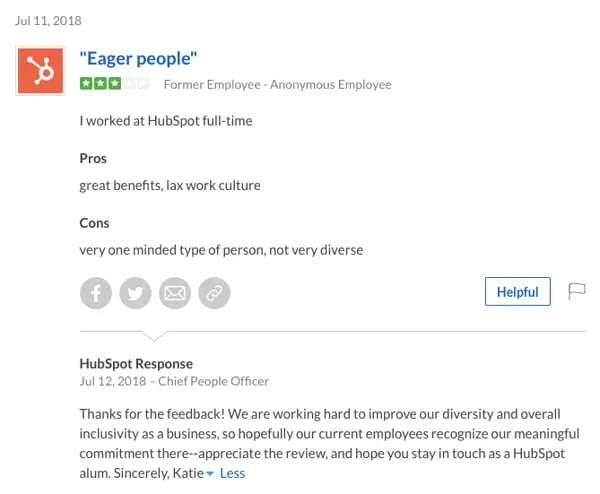
6. Share positive customer reviews you've already received.
When you start receiving positive reviews from your customers, keep the momentum going by highlighting and sharing them so other customers are inspired to do the same.
On Google, Yelp, TripAdvisor, Glassdoor, and many other reviews sites, business owners (and site visitors) can mark certain reviews as helpful, which is like upvoting and moves reviews further up on the site so more people can read them. Make sure to periodically do this to positive reviews so your company's page highlights the cream of the crop.
You could also share positive reviews on your brand's social media channels to open up the option to your audience there. You could reshare positive Facebook reviews in a post on your page, or you could format positive reviews as quotes for Instagram to post for your followers.
Social proof is a powerful marketing tactic — it means that, if customers see other people like them sharing reviews, they're more likely to do the same by following the crowd. So make sure that, in addition to asking for new customer reviews, you're promoting the positive ones you receive across your brand's channels for promotion.
7. Give your customers a positive review first.
If you want customers to leave you a review, you could leave them one first to get the ball rolling.
This may not always be possible (depending on your industry or product), but in a lot of cases, you can get customers to reciprocate your positive words.
If your product or service allows customer profiles to be reviewed — Uber, Lyft, Airbnb, VRBO, and TurnKey are examples — then leave them a positive review if you'd like them to review you in return. Of course, if they were bad customers, you don't have to do that, but if you want to garner more reviews, taking the first step could prompt them to leave you one in return.
Another good option is recommending your customer on LinkedIn. If you're in an account management role and you work with individuals over a long period of time, you could leave them a recommendation or endorsement on LinkedIn. Those go a long way for their own personal branding and might compel them to reciprocate on their own by leaving your business a positive review. And if they thank you for the endorsement, you could politely ask them for a specific review on a different platform during that exchange.
Customer: Thanks for endorsing me on LinkedIn! I appreciate it.
Business Representative: You're welcome! I've enjoyed working with you over the last few months and wanted to make sure other people know how skilled you are at web design. If you've enjoyed working with me as well, I'd appreciate a review of our product on G2 Crowd if you're up for it.
I only recommend this strategy if you've built a relationship with the individual over the course of working together. If an unknown person starts endorsing the customer for random skills on LinkedIn, that might seem creepy, and likely won't result in them reciprocating.
8. Host an event.
To create opportunities to ask for reviews in-person as details in the previous strategy, and to create the conditions where customers are more likely to leave positive reviews, host a remarkable user conference or industry event to create more value for your customers beyond just the products or services you sell.
By creating an engaging and useful experience for customers, where they can network with a community of people like them, get access to new product releases and discounts early, and meet their points of contact at your company, you'll increase their positive sentiment toward your business and engender the likelihood that they'll leave more reviews.
You could even make customer reviews a part of your post-event feedback process — after customers complete a survey asking how they'd rate their experience, you could ask them to share highlights of their experience at the event on a public review site.
Clever or Unique Ways to Ask for Reviews
- Use social media.
- Send a handwritten note and gift card.
- Help your customers when they need it.
- Give employees rewards for positive customer reviews.
1. Use social media.
While using social media to gather reviews isn't exactly clever, the place you ask for them can be unique. For instance, if you have a Facebook group or LinkedIn group, you could ask those members to leave a review.
Chances are, that if they're in your social media group, then they like your company and will provide a positive review if you ask.
Additionally, you can use social media to promote your reviews. For example, one company I follow on Instagram, Bowmar Nutrition, responds and reposts reviews to their Stories every single day. As a follower, I know that if I leave a review on Instagram, it'll be shared by the company. This provides an incentive because it helps develop a relationship with your customers.
2. Send a handwritten note and gift card.
It might seem a little old school, but if you're running a company, a handwritten note to your customers will go a long way. Your sales reps can write these if you're at a mid-size or larger company, or if you run a small business, you can write them yourself. You might consider sending a gift card to your loyal and happy customers, just thanking them for being a customer.
While you can't and shouldn't ever purchase reviews, it's okay to send your customers a nice thank you gift, whether they leave a review or not. Your note could say something like, "We wanted to thank you for being a customer with this gift card! If you ever feel inclined, we'd love to get your honest feedback in the form of a review."
3. Help your customers when they need it.
When times are tough, be there to help your customers. For example, during the COVID-19 pandemic, HubSpot offered reduced prices for prospects and customers, increased limits for customers, and offered a six-month advance on commissions from HubSpot to all Platinum, Diamond, and Elite Solutions Partners.
Again, we weren't doing these things just so customers would leave good reviews, but so we could actually help customers during an unprecedented time. Many customers, new and old, were so positively impacted, that they felt compelled to leave a positive review.
Helping your customers and putting them first will give you goodwill and then inspire positive reviews.
4. Give employees rewards for positive customer reviews.
A month ago, I went to an escape room with my family. After we escaped the room (with 5 minutes to spare, I might add), we were talking to our guide and asking him questions.
After our discussion, he told us his name again and said that he'd really appreciate it if we left a review because they get extra tips if a review calls them out specifically.
Offering your employees a reward for positive reviews gives them a reason to ask happy customers for a review. It also incentivizes customers. I wanted to help our guide because we had such a great experience, so my family and I all left separate reviews calling him out.
To begin implementing customer review cultivation at scale, the best thing you can do is incorporate it into your business as a process. This starts with an active strategy for customer service as well as online reputation and testimonials. Start by building from templates and asking your existing customers for reviews.
Editor's note: This post was originally published in December 2018 and has been updated for comprehensiveness.
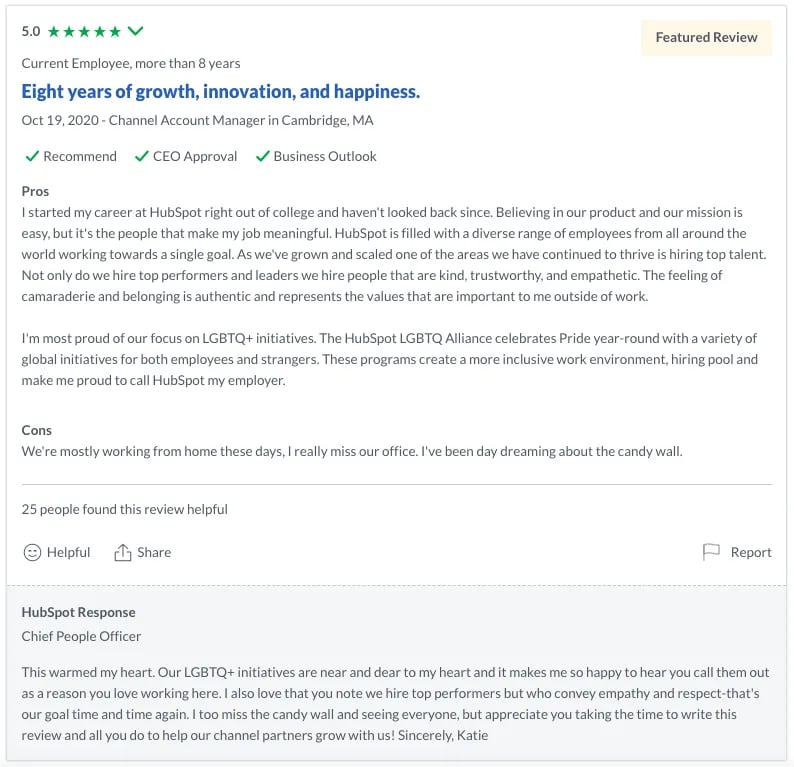
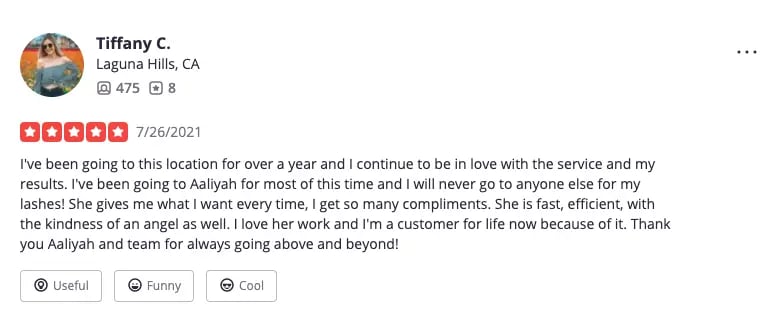
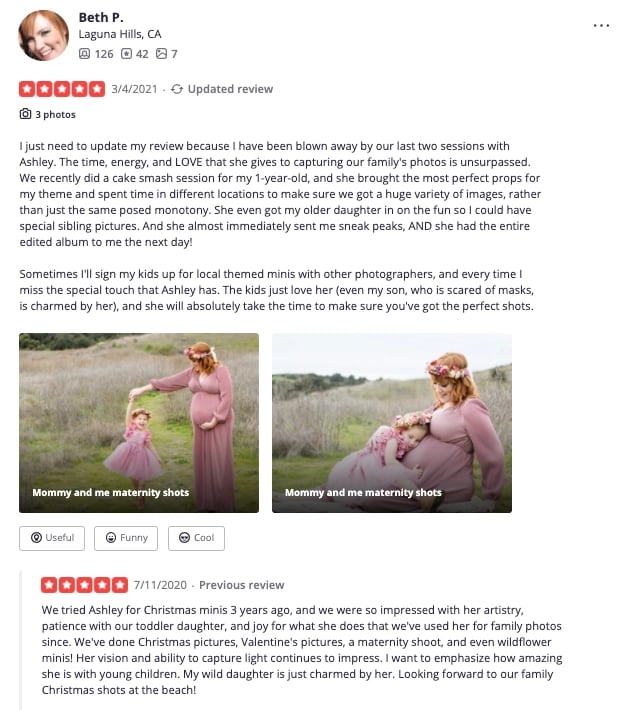


![How to Respond to Customer Complaints [+Complaint Response Examples]](https://blog.hubspot.com/hubfs/Copy of Featured Image Template Backgrounds (8)-1.png)

![5 Expert Tips for Responding to Customer Reviews [+ Examples]](https://blog.hubspot.com/hubfs/customer reviews examples_featured.png)






